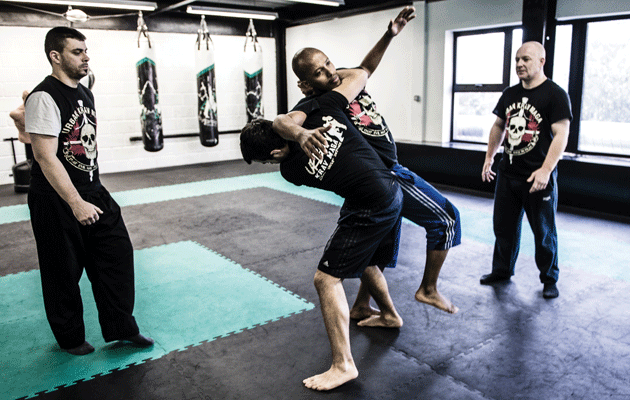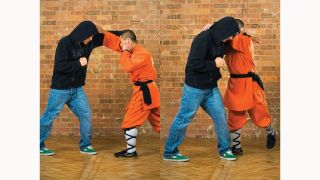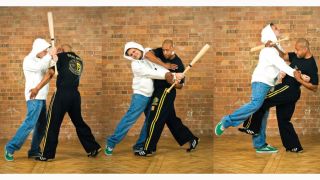
For a split second as I’m sailing through the air, time seems to slow down – like a scene from The Matrix – as I comprehend the force with which my face is about to hit the floor. I’ve been training in Urban Krav Maga for an hour and already I’m wondering if signing up for a five-day course was a smart idea.
I have just enough time to think this before my head bounces off the mat, followed swiftly by the rest of my body. My attacker, not satisfied with dumping me on the floor, drops his knee on my face while hyperextending my elbow joint. Pain jolts through my arm, forcing me to concede by slapping the mat. It’s going to be a long day.
Real self-defence
Plenty of martial arts make bold claims about how effective they are for self-defence, but when your back’s against the wall – perhaps the one outside the kebab shop at 3am – you want one that’s tried and tested. Enter Urban Krav Maga. Devised by instructors Stewart McGill and Leo Negao, UKM is influenced by traditional krav maga – a self-defence system developed by Israeli Special Forces – with a few added tweaks and techniques.
I arrive at Pyramid Martial Arts in southeast London early, keen to find out as much as I can before starting my five-day intensive course. "We base our self-defence and fighting system around the ten most common street attacks and teach our students how to defend themselves against them," McGill tells me. "Our system incorporates techniques from a variety of fighting systems, including boxing, Brazilian jiu jitsu and Muay Thai, among others."
I’ve trained a little in all of these martial arts over the years, but always in a sport-specific context, so I’m intrigued to see how UKM blends and adapts them for street fighting. After shaking hands with my fellow students – most of whom have years of experience in other styles and are in the final stages of qualifying as UKM instructors – we head to the mats to begin training.
Take it to the street
McGill splits us into pairs and begins our introduction to common street attacks. "Everything’s based around the principle of leverage," he says. "We take the view that you’re always going to find someone who’s bigger and tougher than you – or somebody who’s high on booze or drugs, which can make them pretty immune to pain – so we try as much as possible to make our techniques not dependent on strength."
First up is the most common attack of all, which you’ve probably seen countless times outside nightclubs: the two-handed shove to the chest followed by a sloppy, looping punch to the head. McGill teaches me how to keep my hands in front of me in a seemingly passive, prayer-like position – known as ‘the fence’ – to keep my attacker at range, before stepping through and under his punching arm, locking my hands around his neck and throwing him over my hip.
Get the Coach Newsletter
Sign up for workout ideas, training advice, reviews of the latest gear and more.
It takes me a few attempts to grasp the finer points of the move, but as soon as I get it right I’m amazed to find my training partner goes flying over my hip with minimum effort – even though he outweighs me by at least 10kg. McGill then demonstrates how to go straight from the throw into a nasty armlock. I’m trying to do the move carefully, so as not to hurt my training partner, but my lack of technique and co-ordination is making it tricky.
After a few minutes’ practice, it’s my partner’s turn to throw me. I’ve been taught how to break a fall, but the ease and speed with which he launches me into the air catches me off-guard and before I know it, the momentary sense of weightlessness is replaced by numbing pain as I slam into the mat. Clearly, leverage is key.
Bare knuckle
After a couple of hours learning pre-emptive street-attack defences, it’s time to move to the fighting system. First up is striking. The combination of hand, shin, elbow and knee strikes McGill shows us is clearly influenced by Muay Thai, with power generated from the hips and footwork crucial. But there’s one key difference – all the punches have been replaced by open-handed palm strikes.
The reason is simple. "Punching with bare knuckles on the street isn’t a good idea, unless you want to break your hands," says McGill in a disarmingly matter-of-fact way. Point taken.
After an hour of drilling and light sparring, it’s time to hit the ground. "We have an extensive ground-fighting system based on things like Brazilian jiu jitsu and Olympic wrestling," says McGill. "The key difference is our system emphasises getting up quickly, because in a street fight you don’t want to spend time on the ground."
Another difference is all the throws, chokes and joint locks have been modified to include eye gouges, groin strikes and a variety of nasty techniques that will get you disqualified in a martial arts tournament but are fair game if you’re being attacked by a stranger at a cashpoint.
Bearing arms
Finally we focus on weapons defence. Like most forms of krav maga, UKM is designed to prepare you for the worst-case scenario, hence its popularity among military and law-enforcement organisations. In keeping with the rest of the system, the weapons techniques are designed to be as simple and efficient as possible, with minimal margin for error.
After an hour spent drilling various defences for knife and gun attacks, I suggest to McGill that no matter how proficient I become at these techniques, I’d still rather give a mugger my wallet than risk getting stabbed. "That’s all well and good," he says, "but if there’s a psycho with a knife and he’s just gutted the guy standing next to you, would you rather do nothing and get stabbed or try a technique that might save your life?"
At the end of the course, it’s time to see if I can put the techniques I’ve learned into practice in a drill called "pressure testing". After a minute of high-intensity combat cardio – so you get used to fighting while fatigued – you face multiple foes for four minutes. They can hit you with any attack, with everything performed at full power apart from strikes to the head. As I watch my fellow students get pressure tested, I wonder how I’m going to remember all the blocks, throws and strikes I’ve been taught that day. But I don’t have long to dwell on it because suddenly it’s my turn to take to the mat.
Pressure point
"For the next minute you have to hit the pads four times then sprawl," says McGill, standing in front of me holding a set of Thai pads. This is unexpectedly draining, and is made worse by McGill smacking me around the head with the pads at random intervals, while my fellow students take it in turns to try to shove me off-balance. After 60 seconds I’m breathing heavily and feeling unprepared for the aggression I’m about to face.
First up is my original training partner, who does me a favour by coming at me with the chest shove we’d drilled earlier. I manage to step through, grab his neck and throw him to the floor. My technique is sloppy but it works, which is crucial in a pressure test. You don’t have time to think – you just do what you can to take out the guy in front of you. It’s chaotic, disorienting and exhausting, but to my surprise and delight I make it through the four minutes without physically or mentally crumbling.
By the end, I’m battered and bruised from head to toe. I’ve given up on trying to memorise all the techniques – there’s a reason it takes years to master a martial art – but the course drilled the basic principles of UKM into my head and I’ll feel a lot more confident next time anything kicks off outside the kebab shop.
For more info on Urban Krav Maga, visit urbankravmaga.com
Urban Krav Maga Moves
Shaolin head cracker
34th-generation Shaolin kung fu master Shifu Yan Lei suggests this mugger-mashing move.

"To repel a left-handed head punch, move your left leg forward and to the left as your assailant starts to launch his attack. Then push your right hand towards the inside of his left shoulder, with your fist open so you send his punch wide.
"Lock your right hand under his shoulder, bring your right foot forward and lock your left hand on his neck, on the same side as your right shoulder grip."
Krav Maga crippler
Director of training of the UK wing of the International Krav Maga Federation Nick Maison shows us a move to take out bat-wielding thugs.

"To defend a baseball bat attack, to your left side, step forward with your left foot to close the distance between you and your attacker. Bring your left shoulder round so you block his forearms. This will stop the bat hitting you.
"Wrap your left hand around both of his forearms and pull him towards you, then slam your right elbow into his face.
"Follow through and grab the bat with your right hand, then pull your arm back across his face so the top of the bat smacks his head. Use your left knee to smash him in the groin, then move back and scan the area for other assailants."
Between 2010 and 2016, Ben was the deputy editor of Men’s Fitness UK, which predated, and then shared a website with, Coach. Ben also contributed exclusive features to Coach on topics such as football drills, triathlon training plans and healthy eating.

